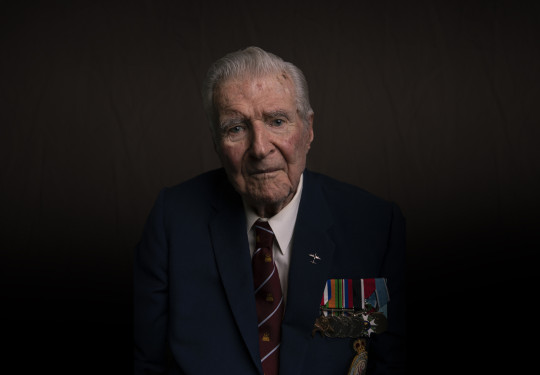RNZAF 85: Flying Officer Arthur "Joppy" Joplin
Served c1940-1946
Arthur Joplin joined the Royal New Zealand Air Force so long ago, he can’t quite remember the exact year.
01 April, 2022
“I don’t know, around 1940 I suppose. I think we were given the choice of Army, Navy or Air Force and I chose the Air Force. I don’t know why.”
But while the 98-year-old might have forgotten a few details, he remembers his career in the Air Force with stark clarity.
“The reason I ended up being a pilot was a bit of luck. To be a pilot you had to be pretty lucky to get through all the tests they gave you. That’s my theory.”
After training at Ashburton in Tiger Moths and with the world in the midst of war Mr Joplin volunteered to be sent overseas, “where all the excitement was”. He flew Lancasters alongside the legendary Dam Busters in the Royal Air Force’s No. 617 Squadron.
“Again, that was luck,” he said.
“During training we were flying a big four-engine aircraft, which was a beautiful aircraft to fly. My last bombing exercise was done one night – it really was a perfect night and the aircraft flew very steadily and every bomb we dropped was either very close or a near hit and that was what got us onto 617.”
The squadron was known for its daring dam buster flights, however Mr Joplin wasn’t involved in those missions. But he was a key player in helping to destroy Hitler’s favourite ship, the Tirpitz.
“We didn’t know that at the time – it was just a ship up in Norway. But it was a danger, it was the biggest battleship in the world and everyone was scared that if it got out, it would do a lot of damage. Its guns could hit a target that was out of sight. So anyway, it had to be sunk.”
When describing the Tirpitz, British Prime Minister Winston Churchill said, “The destruction, or even the crippling, of this ship is the greatest event at sea at the present time. No other target is comparable to it”.
No. 9 Squadron and No. 617 Squadron were chosen for the mission, to take place on November 12, 1944. The behemoth Nazi battleship, weighing nearly 43,000 tonnes and 251m long, was the biggest ship in the world – 2,000 tonnes heavier than its sister ship Bismarck.
Remembering the operation, Mr Joplin said a couple of planes landed direct hits and his crew dropped a bomb that landed close to the ship, causing shockwaves delivering a blow to its integrity. The sinking of the Tirpitz became a pivotal moment in the war.
“People reckon you can still see the hole where my bomb landed. It must have shaken the earth a bit.”
The following month Mr Joplin’s luck ran out as his aircraft crashed on its return to base. Running low on fuel and in thick fog, two of the aircrew died in the crash and Mr Joplin broke both of his legs.
Led to believe the crash was his fault, he received a red endorsement in his logbook. It wasn’t until more than 70 years later he learned nine other aircraft crashed in the conditions and he should have been directed to a closer base in Scotland where the weather was clear.
“They rescinded the red endorsement 75 years later, which didn’t mean a thing by then,” he said.
“I came home in December 1946. When I came back I wasn’t really able to talk about my wartime experiences because most of the crew I flew with were all English in the RAF. The only other New Zealander in the crew was [bomb aimer Flight Sergeant] Loftus Hebbard from Mosgiel in Otago. So we couldn’t get together that often. I was really on my own.”
He later told media there was no pleasure in going to war.
“You’re doing a job and you just did it. You couldn’t think too much about it or you couldn’t cope.”
